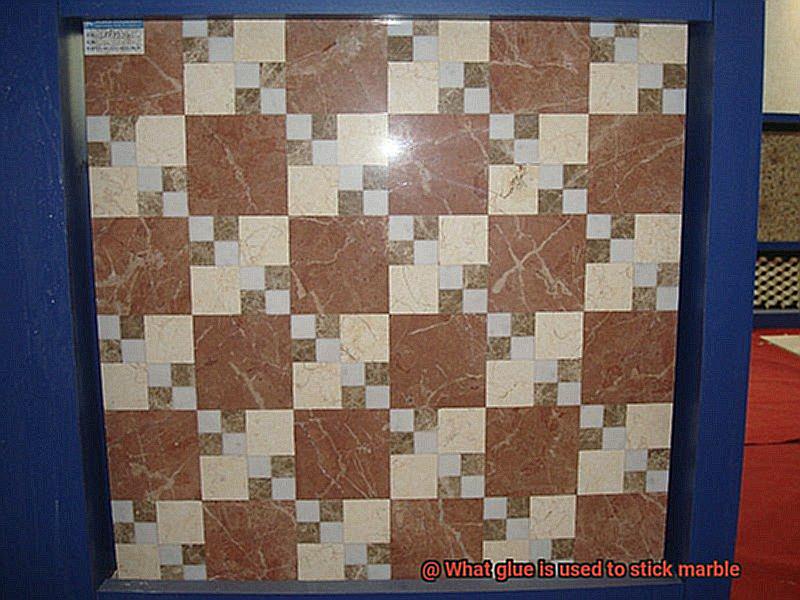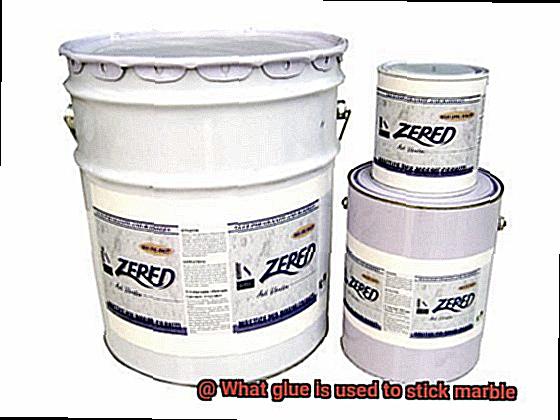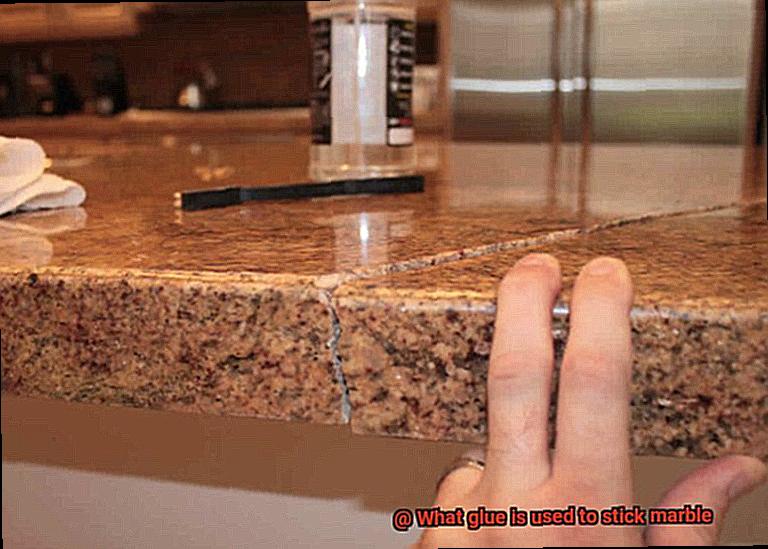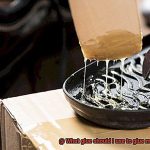Step into any magnificent architectural wonder, whether it’s a grand mansion, a breathtaking monument, or an intricately crafted sculpture, and you’ll be captivated by the mesmerizing marble work. The seamless beauty, intricate patterns, and delicate craftsmanship are a testament to the skilled hands and meticulous attention to detail that went into creating these awe-inspiring structures.
But have you ever pondered how these seemingly weightless marble pieces come together to form such enduring masterpieces? The secret lies in the adhesive that binds this captivating marble – the glue.
Join us on this intriguing journey through the world of marble bonding as we uncover the mysteries and reveal the answers to the age-old question: What glue is used to stick marble?
Are you a passionate DIY enthusiast, an aspiring artist, or simply curious about the technicalities behind marble bonding? Well then, you’ve come to the right place. Let’s embark on this fascinating exploration together as we unravel the secrets hidden within the realm of gluing marble.
Throughout this captivating blog post, we will delve into the essential qualities one should look for in a marble adhesive. We’ll explore different types of adhesives available and highlight the best glue options for specific marble applications. From epoxy resins to polyurethane adhesive, we leave no stone unturned in our quest for that perfect bond.
So whether you’re restoring a cherished marble sculpture, creating a mosaic masterpiece, or simply repairing a chipped corner, our comprehensive guide will equip you with all the knowledge needed to choose the ideal glue for your marble project.
Get ready to unlock the science behind the striking beauty of marble and discover the secrets of achieving a flawless bond that will stand strong against time. Together, let’s embark on this mesmerizing journey and unlock the art of marble bonding.
Adhesives for Sticking Marble: Epoxy Resin
Contents
- 1 Adhesives for Sticking Marble: Epoxy Resin
- 2 Adhesives for Sticking Marble: Polyurethane Adhesive
- 3 Adhesives for Sticking Marble: Specific Marble Glue
- 4 Factors to Consider When Choosing an Adhesive for Marble
- 5 Surface Preparation for Bonding Marble
- 6 Applying the Glue to Bond Marble
- 7 Clamping or Securing the Bonded Pieces Together
- 8 Avoiding Unsightly Residue When Using Glue on Marble
- 9 Conclusion
Marble, a material known for its durability and luxury, is commonly used in construction, sculpture, and decorative applications. When working with marble, selecting the right adhesive is crucial to ensure a seamless and solid structure. Among the adhesive options available, epoxy resin shines as a favorite due to its exceptional bonding properties and durability. In this article, we will delve into the reasons why epoxy resin is the preferred choice for sticking marble.
A Bond That Stands the Test of Time:
Epoxy resin, a dynamic two-part adhesive consisting of liquid resin and hardener, unleashes a chemical reaction upon mixing. This reaction creates a bond that is not only strong but also permanent, firmly securing marble surfaces together. Whether you’re dealing with large slabs or intricate pieces, epoxy resin’s reliability and long-lasting hold make it an ideal adhesive.
Bridging Gaps with Flawless Precision:
One of the remarkable advantages of using epoxy resin for sticking marble is its ability to fill gaps and voids in the surface. This becomes particularly useful when working with uneven or irregular marble pieces as the adhesive effortlessly fills in any imperfections, resulting in a smooth and seamless finish. The end result is a flawless project that exudes beauty and perfection.
Defying Nature’s Elements:
Epoxy resin proudly showcases its resistance to moisture, chemicals, and temperature fluctuations, making it suitable for both indoor and outdoor applications. Regardless of whether your marble installation faces water exposure, sunlight, or harsh chemicals, the bond created by epoxy resin remains unyielding. This durability ensures that your marble structures retain their strength and splendor over time.
Versatility That Knows No Bounds:
Another defining characteristic of epoxy resin lies in its versatility. Not only does it excel at sticking marble together, but it can also bond various other materials such as wood, metal, and glass. This adaptability makes epoxy resin the go-to adhesive for projects that involve joining multiple materials. Craftsmen and DIY enthusiasts alike praise its versatility, knowing they can rely on it for a wide range of creative endeavors.
Adhesives for Sticking Marble: Polyurethane Adhesive
Prepare to be amazed by the extraordinary power of polyurethane adhesive when it comes to bonding marble. This adhesive, made from a potent combination of polyols and isocyanates, creates an unbreakable bond that can withstand even the harshest elements. In this article, we will explore the remarkable capabilities of polyurethane adhesive and provide you with expert tips for achieving flawless results.
The Mighty Composition of Polyurethane Adhesive:
Polyurethane adhesive is a force to be reckoned with, composed of polyols and isocyanates that combine to form a bond of unparalleled strength and durability. Its resistance to water, heat, and chemicals makes it the ideal choice for environments where marble may face these challenges.
Preparing for Victory:
Before embarking on the application process, it is crucial to prepare the surfaces to be bonded. Thoroughly cleaning the surfaces and removing any dust, debris, or oils will pave the way for a bond that stands the test of time.
Applying with Precision:
To unlock the full potential of polyurethane adhesive, precision is key. Utilize a notched trowel or a similar tool to apply the adhesive evenly to both surfaces, creating ridges that enhance adhesion. Remember, even distribution ensures an unyielding bond.
The Perfect Union:
With the adhesive skillfully applied, it is time to bring the marble pieces together. Apply firm pressure across the entire surface, ensuring every inch is engaged in a harmonious union. Employ clamps or other supports to hold the marble in place while the adhesive cures, demonstrating patience as curing times may vary.
Banishing Excess:
Once the polyurethane adhesive has fully cured, it’s time to bid farewell to any remnants of excess adhesive. With a gentle touch, use a scraper or similar tool to remove any remaining traces, all while safeguarding the delicate marble surface.
Choosing Your Arsenal:

Polyurethane adhesive comes in various forms, each catering to different needs. Cartridges designed for caulking guns and two-part systems requiring mixing before application offer versatility to suit any project. Consider the size of your endeavor and personal preference when selecting the perfect weapon for your adhesive arsenal.
Adhesives for Sticking Marble: Specific Marble Glue
Get ready to be captivated by the world of adhesives for sticking marble as we delve into the remarkable realm of specific marble glue. These adhesives are specially engineered to create strong and enduring bonds, capable of withstanding the weight and stress that marble can exert.
First and foremost, let’s explore epoxy adhesives, a popular choice for sticking marble. Known for their exceptional strength and durability, epoxy adhesives consist of two parts – a resin and a hardener – that must be mixed together before application. It’s important to work swiftly with epoxy adhesives as they have a limited working time before they begin to harden.
Another noteworthy option is polyurethane-based adhesive, which offers flexibility that absorbs natural movements and vibrations within marble. This quality helps prevent the bond from becoming brittle and susceptible to cracking over time.
However, not all adhesives are suitable for all types of marble. Some may be specifically formulated for certain marble varieties or have limitations regarding temperature resistance or compatibility with certain chemicals. Therefore, it’s prudent to consult the manufacturer’s instructions or seek professional advice when selecting an adhesive for sticking marble.
Beyond the type of adhesive, several other factors play a crucial role in choosing the right marble glue. Consider the color of the adhesive, ensuring it matches or complements the color of the marble to achieve a seamless bond. Additionally, pay attention to the viscosity or thickness of the adhesive, as it should adequately fill any gaps or voids in the marble surface in order to establish a robust connection.

Proper surface preparation is paramount for achieving successful bonding with marble glue. Thoroughly clean the surface, ensuring it is dry and free from dust, debris, or contaminants that could hinder adhesion. Applying a primer or bonding agent on the marble surface before adhesive application can further enhance bonding performance.
When it comes to applying the adhesive, precision is key. Follow the manufacturer’s instructions meticulously, using the recommended amount of adhesive, applying it evenly and consistently. Allow ample time for curing or drying before subjecting the bond to any stress or load.
Once the adhesive has fully cured, handle the bonded marble with care, avoiding unnecessary stress or impact that could compromise the bond’s integrity. Regular maintenance and cleaning of the marble surface will also contribute to its longevity and prevent potential issues.
Factors to Consider When Choosing an Adhesive for Marble
Marble, with its delicate beauty and weighty presence, demands an adhesive that can withstand its every whim. Let’s embark on a journey to uncover the essential factors that will guide you towards the ideal adhesive for your marble projects.
First and foremost, let’s discuss the star of the show: bonding strength. The adhesive you choose must possess the strength to create a bond that can endure the weight and strain of marble’s majestic presence. This is no time for fragility – your adhesive must be able to hold its ground.
Next, we must consider compatibility with marble. This natural stone is a sensitive soul, vulnerable to the touch of certain chemicals. Choosing an adhesive that is not specifically designed for marble could lead to a disastrous outcome – discoloration, staining, or worse, damage to the precious stone. Seek an adhesive that has been crafted with marble in mind, ensuring a harmonious and respectful union.
Transparency takes center stage as we move onto our next act. When adhering marble, it is imperative that the adhesive remains inconspicuous. We want to showcase the beauty of the stone, not draw attention to the adhesive that binds it together. Opt for an adhesive that dries transparently or matches the color of the marble – a seamless finish that will leave you breathless.
Flexibility enters the stage as we acknowledge the dynamic nature of marble. Its ability to expand and contract in response to environmental changes cannot be ignored. Therefore, your chosen adhesive should possess a degree of flexibility. Allow your marble to sway and dance without fear of compromising the bond.

Time is of the essence as we move swiftly forward. Consider the setting time of your adhesive – a crucial factor depending on your project requirements. Do you need an adhesive that sets quickly, allowing for immediate progress? Or do you require more time for adjustments and positioning? Choose an adhesive that aligns with the ticking of your clock.
Moisture, the ever-present foe, makes its appearance. Marble’s porous nature makes it susceptible to moisture absorption, a potentially disastrous scenario. Don’t let this befall your beloved marble surface. Select an adhesive that boasts excellent moisture resistance, especially if your marble will encounter water in a bathroom or kitchen setting. Shield your marble from the perils of discoloration, staining, or weakened bonds caused by the villainous moisture.
Surface Preparation for Bonding Marble
Prepare to be amazed as we delve into the captivating world of marble bonding. Surface preparation is the secret ingredient that ensures your marble project remains flawlessly intact for years to come. Let’s roll up our sleeves and explore the essential steps to achieve a flawless bond.
Step 1: Embrace Cleanliness
Before even thinking about applying any glue, cleanliness is paramount. It’s time to banish dirt, dust, grease, and any other pesky contaminants that might hinder the bonding process. Mix a mild detergent or soap with warm water and gently scrub the surface using a soft-bristle brush or sponge. Rinse thoroughly to ensure no residue is left behind. Remember, abrasive cleaners and scrubbing pads are off-limits, as we want to preserve the beauty of your marble.
Step 2: Dry with Precision
Now that your marble surface is squeaky clean, it’s crucial to eliminate any moisture. Grab a clean, lint-free cloth or towel and meticulously dry every inch of the surface. Pay special attention to hidden crevices where moisture might linger. The aim is to achieve a bone-dry surface.
Step 3: Embrace Texture
Here’s where things get intriguing. We want to create a textured surface that allows our glue to grip the marble like a koala clings to a tree. But don’t go overboard. We’re not aiming to sand down the marble; instead, we want to lightly roughen it up.
Employ fine-grit sandpaper or a diamond abrasive pad and gently add texture without removing material. Apply just enough pressure to get the job done without causing damage. And remember, consistency is key – always sand in one direction to maintain a sleek, uniform appearance.
Step 4: Unleash the Glue
Finally, the moment we’ve all been waiting for – it’s time to apply the glue. The type of glue you choose will depend on various factors, such as the marble type and intended use of the bonded piece. Epoxy-based adhesives are renowned for their exceptional strength and durability.
They come in liquid or paste forms, offering versatility in application. Follow the manufacturer’s instructions precisely for correct mixing ratios and application methods. Alternatively, polyurethane adhesives provide excellent bonding strength and flexibility, making them ideal for applications with slight movement or vibration. These glues come in different viscosities to cater to various bonding requirements.
Applying the Glue to Bond Marble
Prepare to embark on a journey where the application of glue becomes an art form, creating bonds so secure they’ll leave you in awe. So, roll up your sleeves, grab your trusty brush, and let’s delve into the secrets of applying glue to bond marble like a pro.
Choosing the perfect glue is paramount when it comes to bonding marble. The type of glue you select depends on various factors, such as the type of marble, desired bond strength, and intended use. Let’s explore some popular options that will elevate your marble masterpiece to new heights.
First in our arsenal is the mighty epoxy adhesive. This exceptional two-part wonder combines a resilient resin with a hardener, unleashing a chemical reaction that results in an unparalleled bond. Renowned for its durability, epoxy adhesive can withstand moisture, heat, and chemicals with ease. Not only that, it leaves behind a clear and aesthetically pleasing finish, adding a touch of perfection to your project.
Next up, we have the versatile polyurethane glue. This adhesive not only boasts incredible bonding strength but also offers flexibility like no other. As it cures, polyurethane expands, adeptly filling in any gaps or irregularities on your marble surfaces. It’s a lifesaver for those challenging uneven or porous marbles that require extra attention. Rest assured, polyurethane glue can handle moisture and temperature changes like a seasoned pro, making it suitable for both interior and exterior applications.
Let us not forget about our friendly acrylic-based adhesives. These gems are ideal for bonding light-colored marbles since they resist yellowing over time. However, bear in mind that acrylic adhesives may not match the sheer strength and durability of epoxy or polyurethane glues. Choose wisely, depending on the unique needs of your project.
Last but certainly not least, we have the polyester resin adhesive. This formidable option offers a powerful bond, but it does demand a higher level of expertise to work with. If you’re up for the challenge, it can be an excellent choice to achieve outstanding results.
Now that we’ve explored our glue options, let’s dive into the intricacies of applying the glue to bond marble. Here’s a step-by-step guide to ensure your marble bonding adventure is a resounding success:
Clamping or Securing the Bonded Pieces Together
In our previous exploration, we unveiled the secrets of selecting the perfect adhesive to elevate your projects. Today, we embark on a crucial step in the marble bonding process – clamping or securing the bonded pieces together. Brace yourself, for this step holds the key to flawless and enduring marble bonds. Let’s dive deep into the art of clamping.
The Importance of Clamping or Securing:
Imagine painstakingly applying a robust adhesive to your marble pieces, envisioning a bond that will withstand time. Yet, without proper clamping or securing, your masterpiece could crumble before your eyes. Clamping ensures the adhesive bonds effectively and keeps the pieces in place until the glue dries completely. It’s like enfolding your bond in a powerful embrace, fortifying it beyond measure.
Choosing the Perfect Clamping Method:
Not all adhesives demand external pressure for a steadfast bond. However, for specific types like epoxy or polyurethane-based glues, clamping becomes a non-negotiable necessity. These adhesives require extended curing times and thrive under pressure. Let’s explore some captivating clamping methods that will raise your marble bonds to extraordinary heights.
Embrace the Soft-Grip:
When selecting clamps for marble bonding, seek companions that exert ample pressure without causing harm to the stone surface. Soft-grip clamps or those adorned with protective pads become your trusted allies. They secure your bond with unwavering strength while safeguarding your precious marble from unsightly scratches and dents.
Enthralling Straps and Bands:
Are you working with majestic, large, or oddly shaped marble pieces? Fear not. Straps and bands come to your rescue like elegant belts that cinch everything together. By wrapping them tightly around the marble, you apply uniform pressure, ensuring an unbreakable bond. It’s a symphony of style and functionality.
Unleash Your Creativity:
In certain cases, clamping or strapping may prove challenging due to the size or shape of your marble pieces. But fret not, for innovative alternatives await your command. For delicate or petite pieces, embracing the force of gravity can work wonders. Place weights gently on top of the bonded area, allowing them to exert downward pressure, securing your bond with grace.
Avoiding Unsightly Residue When Using Glue on Marble
Marble, a symbol of timeless beauty and elegance, deserves to be treated with care. However, when it comes to gluing marble, the risk of leaving behind unsightly residue can make even the most experienced DIY enthusiast cringe. But fear not. As an expert in the field, I’m here to guide you through the process of avoiding any unwanted glue marks on your precious marble surfaces. Join me as we embark on a journey to master the art of gluing marble without a trace.

Selecting the Right Glue:
The first step to achieving a residue-free bond is choosing the right glue for the task at hand. Not all glues are created equal when it comes to marble. To safeguard the beauty of this natural stone, opt for glues specifically designed for marble or those labeled as safe for use on natural stone surfaces. These specialized formulations ensure that no discoloration or damage occurs, providing you with peace of mind.
Prepping the Surface:
Before any glue touches your marble masterpiece, it’s essential to prepare the surface meticulously. Cleanliness is key. Gently cleanse the marble using a mild soap and warm water solution, ridding it of any dirt, dust, or grease. Remember to dry the surface thoroughly before proceeding with the gluing process.
Applying the Glue:
Now that your marble is clean and ready, it’s time to apply the glue. Remember, less is more in this case. Use a small amount of glue and spread it evenly over the surface, ensuring not to go overboard. Excessive glue can seep into the pores of the marble, leaving behind stubborn residue that tarnishes its beauty. If necessary, apply multiple thin layers instead of one thick layer.
Containment is Key:
To prevent any mishaps or accidental spread of glue onto undesired areas of your marble, take preventative measures by masking off the surrounding sections with tape or plastic sheets. This simple yet effective step will contain the glue, guaranteeing it adheres only to the designated spot.
Wiping Away Excess Glue:
Immediately after applying the glue, grab a clean cloth or sponge and swiftly wipe away any excess. Be gentle in your motions to avoid smearing the glue or pushing it further into the marble’s pores. Timeliness is crucial here as removing any residue before it dries will save you from future headaches and frustration.
eEcaSrE2ZSA” >
Conclusion
When it comes to sticking marble, choosing the right glue is crucial.
You want a bond that is strong, durable, and long-lasting. The most commonly used glue for marble is epoxy resin.
This adhesive offers excellent adhesion and can withstand the weight and stress that marble often endures. Its high strength properties make it ideal for securing marble tiles, countertops, or sculptures.
Whichever glue you choose, make sure to follow the manufacturer’s instructions carefully for the best results.






